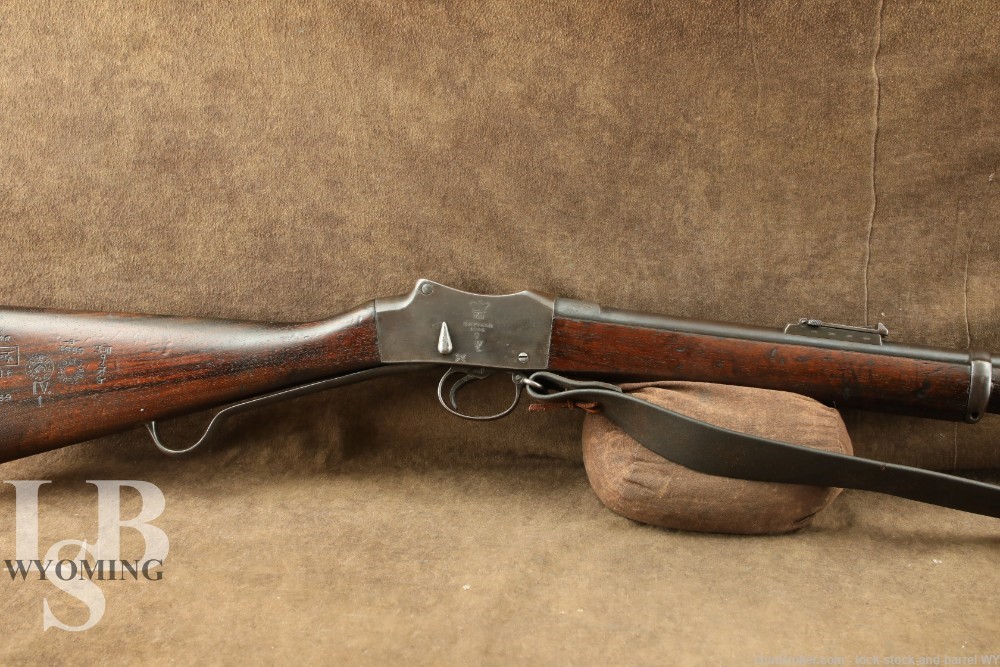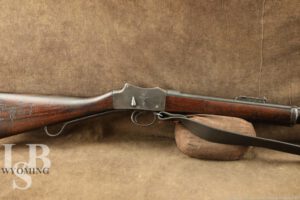
Nepali Martini-Henry Mk. IV B .577/450 Falling Block Rifle Antique 1886
SOLD FOR: $1,775
WOA#: WY240221JM004
Make: Royal Manufactory Enfield
Model: Martini-Henry Mk. IV Pattern B
Serial Number: B1162
Year of Manufacture: 1886
Caliber: ..577/450 Martini–Henry
Action Type: Falling block, single shot
Markings: The right side of the receiver is marked with a crown stamp over “V.R”, “Enfield.”, “1886.”, with a small proof mark, “I.V”, “1.”, and a service acceptance mark. The left side of the barrel shank is marked “B1162”. The top of the barrel shank is marked “F” and with a service acceptance mark. The underside of the stock is marked “669”. The right side of the buttstock is a numerous markings including an “RM Enfield” roundel, a “Firozpur” roundel, “IV.”, and “1”. The left side of the receiver, the left, top, and right sides of the barrel shank, the bottom of the trigger guard, the underside of the forestock, the bottom of the lever, the buttplate, the underside of the buttstock, and the left sides of the barrel bands are all marked with numerous British proof and acceptance marks. The bottom of the trigger guard is marked with Nepali characters. The left side of the barrel is marked “NS NEP”.
Barrel Length: 33.25”
Sights / Optics: The front sight is a shallow blade on a ramped base. The rear sight is a v-notch blade when down and a sliding v-notch blade on a ladder when flipped up.
Stock Configuration & Condition: The two-piece wood stock has a straight grip, metal nose cap, cut out for the included cleaning rod, barrel band with bayonet lug & sling loop, barrel band, trigger guard mounted sling loop, copper lever-head rest, and a metal buttplate. The buttplate has oxidation and some pitting throughout. There are compression marks, scuffs, and scratches throughout the wood. There is a small crack on top of the wrist coming off the back of the receiver. There are a few small cracks in the buttstock coming off the buttplate. There is wear along the cleaning rod channel. The LOP measures 13.8” from the front of the trigger to the back of the buttplate. The stock rates in about Good overall condition.
Type of Finish: Blue
Finish Originality: Original
Bore Condition: The bore is bright and the rifling is sharp. There is light erosion in the bore.
In this writer’s opinion, this bore rates 8 out of 10.
Most antique firearms have bores that will show erosion. This is not only due to age but also to the use of black powder. When fired, black powder reacts corrosively. NRA Antique Firearm Conditions Standards are quite lenient for bores. In some cases, the NRA standards disregarded the bore’s condition for collector’s firearms.
Overall Condition: This rifle retains about 65% of its metal finish. There are scuffs and scratches throughout the metal surfaces. There are areas of pitting throughout the receiver. There is a small chip in the left rear side of the receiver. There is thinning to the finish on the receiver, lever, and barrel exterior. The finish on the barrel bands, nose cap, and trigger guard has been converted to a patina. There is also a patina on the interior walls of the receiver. The screw heads show moderate to heavy use. The pins have light marring. The markings are clear. Overall, this rifle rates in about Good condition.
Mechanics: The action functions correctly. We did not fire this rifle. As with all used firearms, a thorough cleaning may be necessary to meet your maintenance requirements.
Box, Paperwork & Accessories: This rifle comes with a leather sling.
Our Assessment: By the mid-to late 1880s it was becoming very apparent to the British just how far behind the curve they were when it came to the rifle and cartridge they were still fielding as their primary arm. The Martini-Henry rifle had been in service in various forms with the British military since 1871, and replacing it completely would be a long and arduous process. A lot of work was put into the development of a repeating version, or something akin to it, as well as a smaller and flatter shooting .40 caliber round that was similar to the .40 Jarmann cartridge. This resulted in the Enfield-Martini pattern of rifles. This change was later abandoned as the newer magazine fed .303 Lee-Metford rifles were on the horizon and having three rifles with different ammunition types was seen as a logistical nightmare. It was determined to go backwards and convert the Enfield-Martini rifles to fire the older .577/450 cartridges. New barrels were added along with a few smaller changes. These were deemed Martini-Henry Mk. IV rifles, of which there are three patterns with different sources of conversion and other small differences. The Mk, IV rifles were almost entirely shipped out to India for service with the Indian Army. Many found their way to Nepal as well.
This example was made at Enfield in 1886 and is a pattern B converted from a 2nd pattern Enfield-Martini, which can be difficult to determine but the easiest way is to look at the length of the barrel shank. Going off of the markings, this rifle was first sent to the Indian Firozpur Arsenal in Punjab but was later sent to Nepal, which is marked on the left side of the barrel. The stock is in good shape with a few small cracks in the buttstock near the buttplate and the receiver. The metal retains some of its finish, with pitting and areas of patina throughout. The bore is in really nice shape and is bright with light erosion. The markings are very crisp, chiefly those on the buttstock. This is a really nice example of a Mk. IV, especially one that came out of Nepal. This would fit into any British, Nepali, or Martini-Henry collection. Please see our photos.
-99

